Games can have valuable benefits
We rarely participate in contrived game playing (having no purpose other than the game itself). The first "game" we played together (beginning on our irregular visits to our cottage in 2001) was Scrabble, but in a non-competitive method that is far more mentally and interpersonally beneficial than the standard way the game is played. We have come to call this "Cooperative Scrabble". We pick the tiles independently and keep them on our individual racks open to view, then deciding together which words made alternately by each of us will produce the best immediate score and greatest potential for highest combined points. I and Paul see considerable resemblance to life itself in which neither one of us can know exactly that will come our way, but when we work together to choose the optimum immediate and long range action, the joint outcome is far better than if we had operated totally independently. 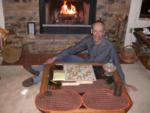 Taking time to create a long word from existing tiles between the two of us in smaller steps of short real words has allowed us to obtain some really interesting words - and high total points. In the middle of January 2008 in a game that took us 4 sittings over 2 weeks, we beat our previous high total of 819 - new high 834! Playing this game in front of the fireplace in the coldest weeks in Arizona is especially enjoyable, although the game often takes 3 nights - and 4 like this last one - since we are trying to optimize our choices, not simply play a game. And then we often do not play again for a few months.
Taking time to create a long word from existing tiles between the two of us in smaller steps of short real words has allowed us to obtain some really interesting words - and high total points. In the middle of January 2008 in a game that took us 4 sittings over 2 weeks, we beat our previous high total of 819 - new high 834! Playing this game in front of the fireplace in the coldest weeks in Arizona is especially enjoyable, although the game often takes 3 nights - and 4 like this last one - since we are trying to optimize our choices, not simply play a game. And then we often do not play again for a few months.
Verbal games with numbers or words can be mentally stimulating - and portable
Not all our hours driving are spent in discussion of deep subject matter. Here are some descriptions of games we have played during various trips:
- While driving to Arizona at the beginning of October 2002, Paul introduced Kitty to a "game" of sorts he taught himself many years ago - quickly determining the number of wheels on all sizes of tractor trailer rigs. Knowing that virtually all transport trailers have their wheels arrayed in sets of 4 across and that the cab has 2 steering wheels on its front, one can rapidly calculate the total number by quickly counting only those seen in profile. An 18-wheeler will be seen from the side to have 5: 1 on the front of the cab = 2, 4 from there back on cab and down the rig = 16; total = 2+16= 18. Put another way, the typical rig has 4 x number rows of wheels seen from the side (omitting the front row) + 2. It was fun for Kitty, new to this concept, to see how quickly she could find a 42-wheeler.
- Kitty shared with Paul on that same trip how, as a child, she learned (from her father while traveling) to make as many words as possible using the letters on license plates, a mental exercise she stills finds herself doing at red lights. Paul, in turn, gets great delight out of seeing all the possible ways that the letters and numbers on a license plate can exhibit symmetry.
- On a subsequent trip we tried another game from Paul's childhood; naming an item from a chosen category - like fruits and vegetables - and the other having to follow that from the same category but starting with the last letter from the prior word. This game can be made even more tricky if the words chosen have to end with the letter with which the previous word began.
- Finding relationships in numbers has been a tool - as well as a game - that Paul has used since childhood, when he first became fascinated with mathematics. For example, he finds it easy to remember our car license plate because the numerical portion is 240 - a "nice" number:
- the prime number factors 2, 3 and 5 are the first 3 prime numbers
- the second digit is twice the first - actually Kitty thinks this is "nice", but not one Paul considers particularly noteworthy, unless the number system used is base 8, in which case each digit of 240 is the double of the previous
- the second digit, 4, is the only value that the side of a square can have so that the perimeter equals the area
- Remembering the words of old songs has been fun (as well as stimulation for the memory) on many a drive as well as at home. There are certain radio stations that play instrumental versions of songs and the challenge then is to be able to sing along. We do pretty well since we both enjoyed listening to many of the songs made popular in the 50s and even before Kitty was born in 1945. (These were ones with, in our opinion, more memorable lyrics.) And to add to the fun, Paul has a very nice singing voice and enjoys using it.
- A game Kitty introduced to Paul, during our numerous drives in May 2005 to and from the Toronto apartment and the cottage 160 miles to the northeast (as part of our full-time relocation for summers in Canada), was one of synonyms. In this case it was all the words we could think of for a thoroughfare on which businesses or homes are located, the most common in English probably being either "road" or "street". By the middle of June - which was after the relocation was complete - we had come up with 28 used in the US and/or Canada, listed on a notebook we kept in the car glove compartment for that purpose. And we had found examples of all of them during that time.

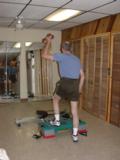
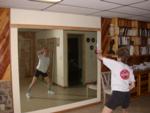
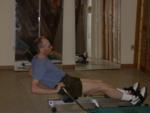
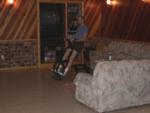
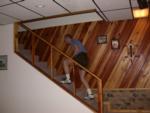
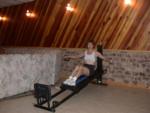
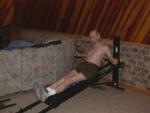
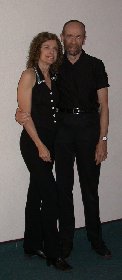
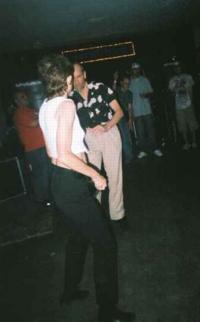 In mid November 2006 after our return from Ontario for the cold months, Kitty found a source of energy dance locations, (now defunct) forums at EDMNEX.us, based in Arizona. She now uses
In mid November 2006 after our return from Ontario for the cold months, Kitty found a source of energy dance locations, (now defunct) forums at EDMNEX.us, based in Arizona. She now uses 